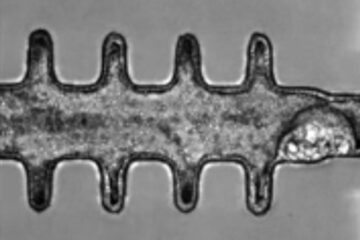The Nanobioengineering Laboratory Leads The Nanometric Scale Research Of A European Project Focused On The Differentiation Of St

The director of the Nanobioengineering Laboratory of the CREBEC and sub-director of the Parc Científic de Barcelona (PCB, Barcelona Science Park), Josep Samitier, will coordinate the research lines on the application of nanobiotechnologies for the differentiation of stem cells in the European project entitled CellPROM, the most funded project in the first call of the VI Framework Programme. Josep Samitier will preside the CellPROM Scientific Committee on Nanotechnologies and will join its Management Committee, together with the coordinator of basic research, Andreas Manz, and the coordinator of CellPROM, Gunter Führ, from the Fraunhofer Institut Biomedizinische Technik.
In addition, the Nanobioengineering Laboratory also coordinates the broadest line of research in the project, accounting for 34% of the scientific effort, which focuses on the development of artificial surfaces that allow the controlled differentiation of stem cells whilst simultaneously minimizing their rejection once implanted in the patient.
The project is based on the premise that stem cells can be differentiated through interactions that take place at the cell surface. The final objective of CellPROM is to develop technologies with therapeutic applications in the field of the so-called tissue engineering by applying the tools provided by nanotechnology and the know-how on the differentiation of adult stem cells. Specifically, by producing cell cultures and tissues that can be used for auto-transplants, the project will allow Europe to lead the development in the new medical technology required to use stem cells for regenerative therapies.
At present, regenerative therapies are underway that, for example, use bone marrow-derived adult stem cells cultured in the laboratory, which are then implanted. CellPROM will develop surfaces that mimic biological ones, on which stem cells can be cultured through molecular signals that facilitate a more precise differentiation into the cells of interest.
Furthermore, the resulting cell cultures can also be used as alternatives to assays that involve experimental animals. These advances will have practical applications in the fields of new medical technology and in the biotechnology, pharmaceutical and agroalimentary sectors.
The final outcome of CellPROM will be a prototype that cannot be used in humans until it has passed the clinical trial phases, which will be started shortly.
The project includes the participation of 27 institutions from 12 European countries, which include prestigious institutes and centres such as the PasteurInstitute in France, the Royal Institute of Technology of Sweden, the University of Vienna and the Institute of Pharmaceutical Technology of Austria, the Swiss Federal Institute of Technology, Lausanne, the Fraunhofer Society of Germany and the University of Barcelona, through the Nanobioengineering Laboratory.
The CellPROM project has a total budget of more than 26 million Euros, 17.6 million of which have been granted by the European Commission. The project was officially presented in Saarbrücken, Germany, on 25 and 26 March 2004.
Media Contact
More Information:
http://www.pcb.ub.esAll latest news from the category: Life Sciences and Chemistry
Articles and reports from the Life Sciences and chemistry area deal with applied and basic research into modern biology, chemistry and human medicine.
Valuable information can be found on a range of life sciences fields including bacteriology, biochemistry, bionics, bioinformatics, biophysics, biotechnology, genetics, geobotany, human biology, marine biology, microbiology, molecular biology, cellular biology, zoology, bioinorganic chemistry, microchemistry and environmental chemistry.
Newest articles

Solving the riddle of the sphingolipids in coronary artery disease
Weill Cornell Medicine investigators have uncovered a way to unleash in blood vessels the protective effects of a type of fat-related molecule known as a sphingolipid, suggesting a promising new…

Rocks with the oldest evidence yet of Earth’s magnetic field
The 3.7 billion-year-old rocks may extend the magnetic field’s age by 200 million years. Geologists at MIT and Oxford University have uncovered ancient rocks in Greenland that bear the oldest…

Mini-colons revolutionize colorectal cancer research
As our battle against cancer rages on, the quest for more sophisticated and realistic models to study tumor development has never been more critical. Until now, research has relied on…





















